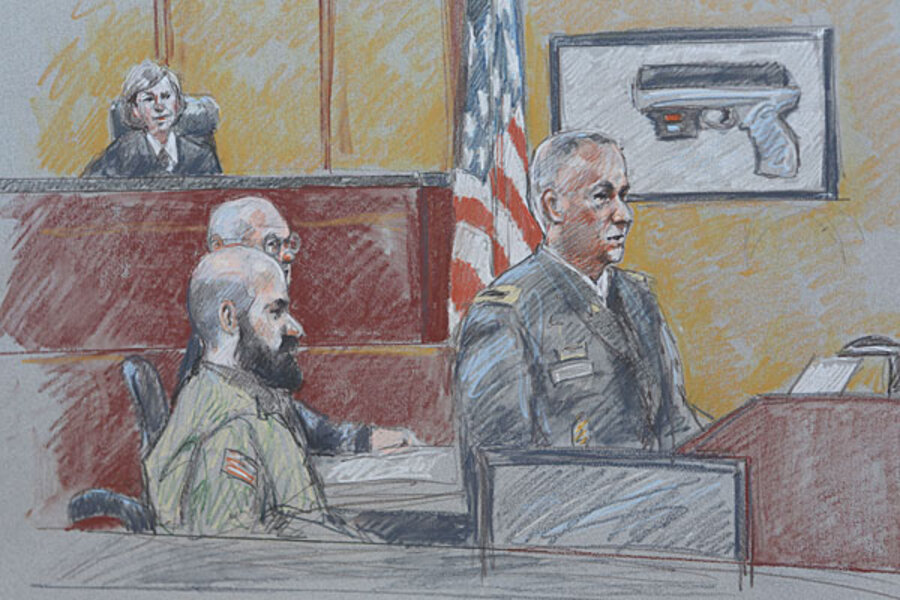Fort Hood suspect tells court he 'switched sides' in America's war
Loading...
The US Army on Tuesday began to try one of its own – Maj. Nidal Hasan – for his role in a deadly attack on deployment-ready soldiers at Fort Hood on Nov. 5, 2009. In his opening statement, Major Hasan, who has long sought to declare his guilt, said that "the evidence will clearly show that I am the shooter."
Hasan is accused opening fire at a training center, killing 13 and injuring scores of others. He was shot by a responding police officer, and is now partly paralyzed from that injury.
Though there is little suspense about the final verdict, the trial – which could last months – is important to the military-justice system, to the victims and their families, and to the still-unresolved question of whether the attack was an act of terrorism. The trial's first day made those stakes clear.
Army ‘absolutely determined’ to win execution
The US armed services have not carried out an execution since 1961. Eleven of 16 military death-penalty cases during the past 30 years have been overturned, leaving five soldiers at Fort Leavenworth, Kan., still awaiting execution.
Military-justice experts say Col. Tara Osborn, the presiding judge, has gone to great lengths to make sure the verdict and sentence in this trial survive any appeals. For example, in the long run up to the much-delayed trial, Hasan pleaded with the court to let him acknowledge his guilt, but Colonel Osborn, denied that request, given that the prosecution is seeking the death penalty. She's also allowed Hasan to defend himself, giving him wide legal leeway.
“This is one case they’re absolutely determined to [not be brought down on appeal]. Since military capital punishment has been so plagued and riddled with errors, they’re tyring to learn from those mistakes [with the Hasan case], and they’re going to [try to get a conviction] pretty much how long it takes, and whatever resources they take,” David Frakt, a law professor at the University of Pittsburgh, told the Monitor earlier this summer.
Victims once again face tormentor
The scene at the readiness center was pure terror and mayhem, with unarmed soldiers trying to flee and hide behind desks and tables. Now victims face the prospect of taking the stand to explain what they saw, and then being cross-examined by man on trial for unleashing the fury of bullets against them.
Osborn's ruling that Hasan can defend himself has been widely seen as an insult to survivors and the families of those who died. Delays in the trial have also worn on possible witnesses and the broader military community in Texas and beyond.
Yet at least some of the 30 victims scheduled to testify say they are anxious to help convict a man they see as a traitor.
"I'm not going to dread anything. That's a sign of fear," injured Staff Sgt. Alonzo Lunsford told the Associated Press. "That man strikes no fear in my heart. He strikes no fear in my family. What he did to me was bad. But the biggest mistake that he made was I survived. So he will see me again."
Terror strike or not?
On its first day, the trial shed light on the motives for the attack. Although President Obama on May 23 said that Hasan’s act may have been “inspired by larger notions of jihad,” the Obama administration has defined the attack as an act of workplace violence.
In his opening statement Tuesday, Hasan said: “Evidence will show I was on the wrong side of America's war and I later switched sides. We in the mujahideen are imperfect beings trying to establish a perfect religion.… I apologize for any mistakes I have made in this endeavor.”
One of the prosecutors, Lt. Col. Steve Henricks, said of Hasan: “He didn't want to deploy [to Afghanistan] and he came to believe he had a jihad duty to murder soldiers.” Hasan, Colonel Hendricks said, wanted to "kill as many soldiers as he could."
Government officials say that starting in 2008 Hasan sent more than a dozen e-mails to Anwar al-Awlaki, a radical cleric whom the US killed with a drone strike in 2011.
In a pretrial motion, Hasan told Osborn that he had acted in defense of “the leadership of the Islamic Emirate of Afghanistan, the Taliban” by targeting US soldiers ready to be deployed to Afghanistan and Iraq. But she said he could not use that defense in court. Legally, experts say, it would be impossible prove, since there was no evidence that the particular soldiers he targeted posed any direct risk to Taliban leaders.
The issue is more than semantic. Victims are ineligible for some Army benefits because their injuries are not classified as "combat related." Meanwhile, Hasan is still collecting a pension.
If classified as a terrorist attack, the Fort Hood shootings would be the deadliest on US soil since 9/11. The shootings fit a shift in the war on terror after 9/11, in which plots attacks against the American homeland were most often carried out by self-radicalized "lone wolves."






